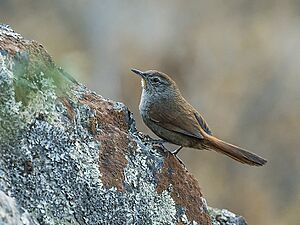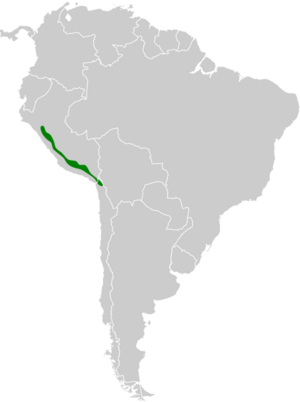Canyon canastero facts for kids
Quick facts for kids Canyon canastero |
|
|---|---|
 |
|
| Conservation status | |
| Scientific classification | |
| Genus: |
Asthenes
|
| Species: |
pudibunda
|
| Subspecies | |
|
See text |
|
 |
|
The canyon canastero (Asthenes pudibunda) is a small bird. It belongs to the ovenbird family, called Furnariidae. You can find this bird in the countries of Chile and Peru.
Contents
Understanding the Canyon Canastero's Family Tree
The canyon canastero has three different types, called subspecies. Think of them as slightly different versions of the same bird. These are A. p. pudibunda, A. p. neglecta, and A. p. grisior.
Scientists have studied the canyon canastero's genes. This helps them learn about its family connections. They found that it is most closely related to another bird. This bird is called the Vilcabamba thistletail.
What Does the Canyon Canastero Look Like?
The canyon canastero is about 15 to 17 cm (5.9 to 6.7 in) long. It weighs around 13 to 17 g (0.46 to 0.60 oz). Both male and female birds look very similar.
They have a thin, light yellow stripe above their eyes. This is called a supercilium. Their face is gray-brown with dark brownish patches near their eyes. The top of their head is a warm dark brown. Their back and rump are a lighter brown color.
Their wings are a dull reddish-brown. The feathers covering their upper tail are chestnut-red. Their tail is a more reddish-brown than their back.
The bird's chin and upper throat are a pale orange color. Their lower throat and upper chest are light gray-brown. You might see faint lighter streaks there. The lower chest and belly are plain pale gray-brown. Their sides and under-tail feathers are a dull reddish-brown.
Their eyes are brown. The top part of their beak is black or dark horn-colored. The bottom part is gray or pinkish. It has a black tip. Their legs and feet are gray to blackish.
Young canyon canasteros look a bit different. Their chin and throat are light gray-brown. Their chest has faint dark bars. Their underparts have a brownish tint.
Where Does the Canyon Canastero Live?
The canyon canastero lives on the western side of the Andes mountains.
- The A. p. neglecta subspecies lives in northwestern Peru. You can find it in the La Libertad and Ancash areas.
- The A. p. pudibunda subspecies lives in the western Lima area of Peru.
- The A. p. grisior subspecies lives in southwestern Peru. It is found from the Huancavelica area south into Chile. It goes as far as the Tarapacá Region.
These birds mostly live in rocky places. They like dry mountain scrublands. You can often find them in deep valleys called ravines. Sometimes, they live in Polylepis woodlands. They usually live at heights between 2,400 and 3,700 m (7,900 and 12,100 ft). But they can be found as high as 4,000 m (13,000 ft).
Canyon Canastero Behavior
How Does the Canyon Canastero Move?
The canyon canastero stays in its home area all year long. It does not migrate.
What Does the Canyon Canastero Eat?
The canyon canastero eats arthropods. These are small creatures like insects and spiders. It usually looks for food alone or in pairs. It picks up prey from low branches and the ground. It often searches in shady spots under rocks or bushes.
When Does the Canyon Canastero Breed?
Scientists do not know much about the canyon canastero's breeding season. They know it includes the month of May. More research is needed to learn about how these birds raise their young.
What Sounds Does the Canyon Canastero Make?
The canyon canastero's song is a loud, fast trill. It starts with a few short notes. Its call sounds like a repeated "kee-whit".
Canyon Canastero's Conservation Status
The IUCN (International Union for Conservation of Nature) has looked at the canyon canastero. They say it is a species of "Least Concern." This means it is not currently in danger of disappearing.
The bird lives in a fairly large area. Its population size is not known. However, scientists believe the number of these birds is going down. No immediate threats have been found. It is thought to be uncommon to fairly common. Much of its habitat is affected by grazing animals.


